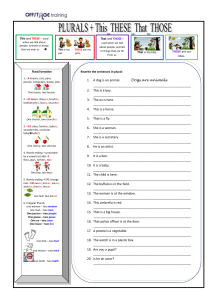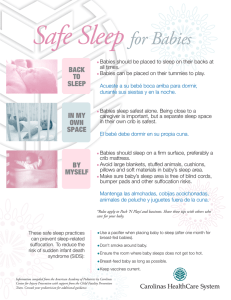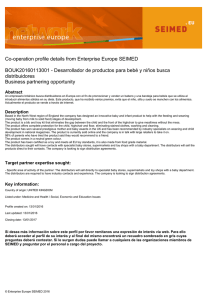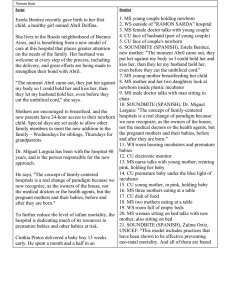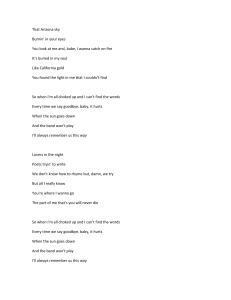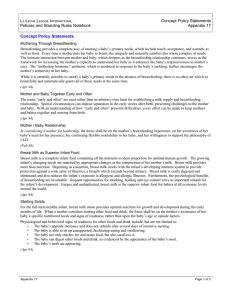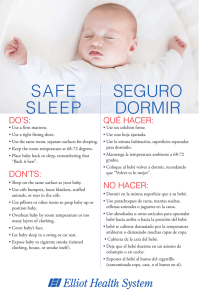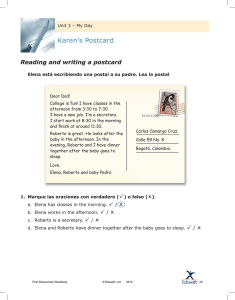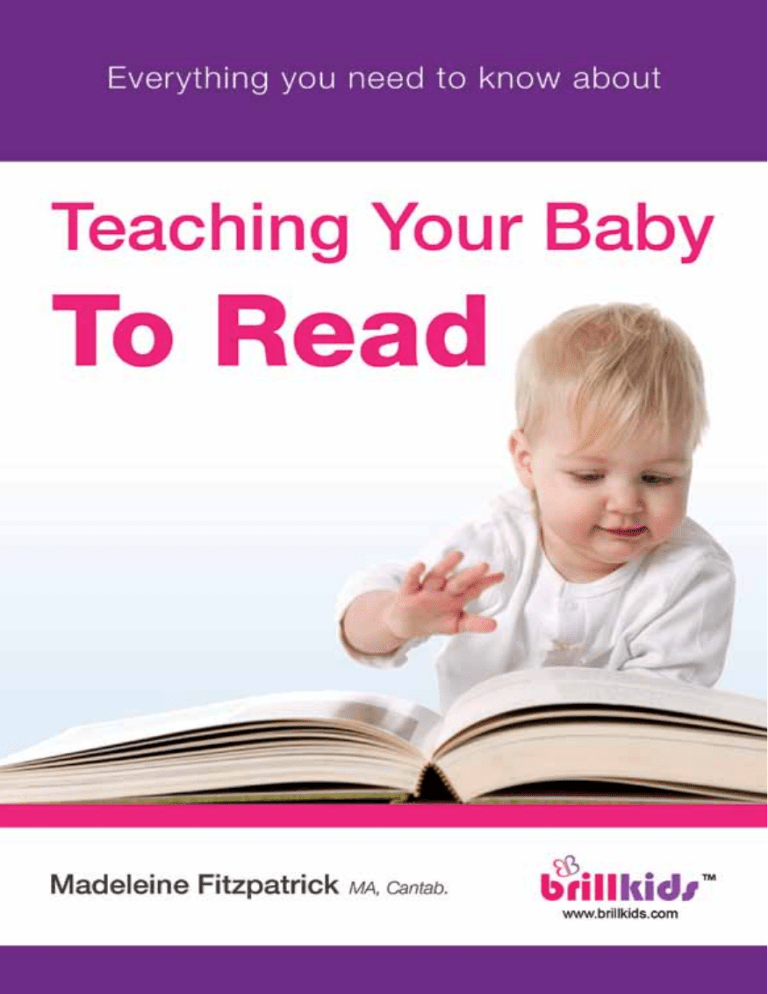
Everything you need to know about TEACHING YOUR BABY TO READ by Madeleine Fitzpatrick MA, Cantab brillkids ™ www.brillkids.com © 2010 BrillKids Inc. All rights reserved. Visit www.BrillBaby.com to learn more! CONTENTS FOREWORD..................................................................................... i Chapter 1: INTRODUCTION................................................... 1 I don’t believe it!.................................................................. 1 Why teach babies to read?.................................................. 1 Shouldn’t I teach the alphabet first?..................................... 2 What if my baby doesn’t enjoy reading?............................... 2 What are the learning methods for babies?.......................... 2 Chapter 2: WHY TEACH READING EARLY?........................... 3 Babies are linguistic geniuses.............................................. 4 Isn’t learning to read supposed to be difficult?..................... 5 From speaking to reading … a giant leap?........................... 6 Reading’s place in history.................................................... 7 The promise of early reading................................................ 8 Early reading can prevent dyslexia....................................... 9 Chapter 3: WHOLE LANGUAGE VS PHONICS...................... 12 Why teach whole language?................................................ 13 Why teach phonics?............................................................ 14 The dyslexia debate............................................................ 16 The voice in the head.......................................................... 17 Earlier is easier.................................................................... 18 Summing up....................................................................... 21 Chapter 4: FLASH METHOD.................................................. 22 Philosophy.......................................................................... 22 Method............................................................................... 23 Chapter 5: MULTISENSORY METHOD................................... 27 Philosophy........................................................................... 27 Method............................................................................... 28 Chapter 6: NATIVE READING METHOD................................. 30 Philosophy........................................................................... 30 Method............................................................................... 31 Chapter 7: CONCLUSION....................................................... 34 Teaching Your Baby To Read | i FOREWORD This book is an attempt to address some of the questions new parents may have when thinking about whether – and when – to teach their child to read. The only reason BrillKids exists is because of my daughter Felicity, who learned to read as a baby. We personally tried everything out there – flash cards, homemade books, DVDs, PowerPoint slideshows… and a prototype computer program that would become the BrillKids Little Reader Learning System. I successfully taught Felicity to read dozens of words by the age of 11 months, and successfully filmed her reading – twice – at 12 months. The videos can be found on the BrillBaby channel on YouTube (youtube.com/brillbaby). By age two and a half, Felicity was reading independently. Today, at age three and half, she reads at roughly third-grade level, and continues to amaze us all with her voracious appetite for books. One of the main reasons I founded BrillKids was to share with other parents the joy in teaching babies to read. I wanted to let parents know that babies can learn to read – and that, most importantly, they love learning to read! I found out after starting the company that the topic of teaching babies to read is a little more complicated than that. Not every parent – or expert – agrees with giving babies reading lessons. On the other hand, research studies have come out supporting the benefits of early reading. Meanwhile, we are seeing more and more videos from around the world of very young children reading. Many of these children are less than a year and a half old. The tools used by their parents to teach them are many and varied. ii | Teaching Your Baby To Read Many of our BrillKids members are finding great success in teaching their children to read. Pearl – a member of our online community – can be seen on the BrillKids website with her son Kael, who at two and a half years old reads complete stories perfectly using Little Reader. No matter when and how you decide to introduce your child to the written word, I hope that you find this book an interesting read. I hope that it answers some of the questions you may have. I also hope that if you do decide to become your child’s first teacher, you will visit us in the BrillKids Forum – where you can meet thousands of other parents teaching their children. Finally, I would like to share something about teaching young children that every parent should know. The number one rule is to have fun doing it! Treat lessons primarily as a time for bonding, and enjoy the experience with your child. As long as you do that, you can’t go wrong. Happy learning! KL Wong Founder, BrillKids Inc. April 2009 Teaching Your Baby To Read | 1 CHAPTER 1 INTRODUCTION Babies reading?! Like many people, your initial reaction may be one of skepticism. But not only is it possible to teach your baby to read, it’s also easy to do (easier than if you wait until your child is five or six years old). More importantly, your baby will love it! If you’ve never encountered babies reading before, you probably have some questions or doubts about whether this is something you’d like to do with your baby. We hope to have answered most of your questions here. If there’s anything you’d like to ask or discuss, we’d love to hear from you in the forum at www.BrillKids.com. “I DON’T BELIEVE IT!” If the idea of babies reading seems far-fetched to you, check out the Baby Reading Videos page at www.BrillBaby.com. There, you can see dozens of babies reading, including Felicity (daughter of the BrillKids founder) and Naimah (daughter of the BrillKids editor), reading at 12 and 16 months respectively. WHY TEACH BABIES TO READ? If you think babies are too young to learn to read, or wonder why anyone would teach a baby to read, the chapter Why Teach Reading Early? is for you. Although teaching babies to read is fun, that isn’t the only reason for doing it. Children who learn to read in their first few years of life experience long-term gains in reading ability as well as other spheres of life. This is something we will discuss in detail in Chapter 2: Why Teach Reading Early? 2 | Teaching Your Baby To Read SHOULDN’T I TEACH THE ALPHABET FIRST? Babies can learn to read whole words without knowing the letters of the alphabet. However, children need to learn phonics in order to progress to phonetic reading (sounding out words). Some people think that children shouldn’t learn to read whole words. We believe that it is beneficial to learn to read as young as possible, and that so long as children learn phonics before they start school, they will be fluent readers. For more on this debate, head straight to Chapter 3: Whole Language Vs Phonics. WHAT IF MY BABY DOESN’T ENJOY READING? Step back, and look at what you’re doing. The cardinal rule of teaching babies is to make it fun. The point of teaching is not to achieve certain targets, but rather to give your baby the opportunity to learn to read at the age when it is easiest for her to do so. Most likely, one of the methods of learning to read will appeal to your child and naturally become integrated into your daily routine. When that happens, the learning process will be fun and effortless, as well as a great chance for parent-child bonding. WHAT ARE THE LEARNING METHODS FOR BABIES? Your baby will not learn to read simply by you reading books to him. You need to start more simply – with single words, and frequent lessons of short duration. How you present them is up to you. Some techniques to consider are the flash method, multisensory method and the Native Reading method, which are described in detail in their respective chapters. Teaching Your Baby To Read | 3 CHAPTER 2 WHY TEACH READING EARLY? The issue of when to teach children to read is a hotly debated one. Increasing numbers of parents are teaching reading early, and increasing numbers of children are learning to read as preschoolers. Yet, there is no shortage of parents, educators and developmentalists opposed to this phenomenon. Some believe that early reading harms children, while others think children are cognitively not ready to learn to read until they start school. A commonly heard criticism is that it is wrong to “push” children to read before the age of five or six. Some would even like to see the general reading age pushed back to seven. It is our belief that teaching children to read at a young enough age frees them from the potential burden of learning to read in school. We believe that it is learning to read too late that actually causes the process to become burdensome. For more on how these views fit in to the debate surrounding early learning as a whole, check out the Early Learning: For + Against section at www.BrillBaby.com 4 | Teaching Your Baby To Read BABIES ARE LINGUISTIC GENIUSES Glenn Doman, founder of the Institutes for the Achievement of Human Potential (IAHP), said it first: babies are linguistic geniuses. Doman points out that while learning to speak one’s native language perfectly may be an everyday miracle, it is a miracle nonetheless: To every baby born in Philadelphia tonight, English is a foreign language – no more and no less foreign than Kurdish or Hindi. And then a miracle happens: he learns his language. How does he learn it? We kid ourselves that we teach him. My foot! We teach him ‘Mommy,’ ‘Daddy’ and ‘no.’ And the other hundred thousand words and a good vocabulary he learns by himself. Doman notes that children learn their language through context; not by having the meanings of words explicitly taught to them (which is the way foreign languages – and reading – are usually taught in school). Likewise, writing about the usefulness of text pointing (running a finger under the words as they are read) in the book Native Reading, computational biologist Timothy Kailing zeroes in on the value of implicit teaching (which children respond well to) over explicit teaching (of the kind children are subjected to in school): Inconsistent and explicit text pointing [when reading to a child] disturbs the attention of a child, it interrupts the cadence of the language, and it ends up making reading more confusing for a child – and a lot less fun… You need to make text pointing a consistent, accurate but unobtrusive habit. Kailing has coined the phrase “native reading” to refer to the natural ability of children under three to acquire an instinctive, intuitive, or native feel for their language – one, he says, that can easily be extended to reading. He believes that any child can learn to read by the age of three provided her home environment provides sufficient correlations between the written and spoken forms of language. Teaching Your Baby To Read | 5 This is similar to Doman’s view that most babies do not learn to read for the simple fact that they cannot see text as it is normally presented to them. Doman advises that by treating the written form of language as we treat the spoken form (i.e. simplifying it for babies), a small child can learn to read as effortlessly and instinctively as he learns to speak: In order to understand language through your ear, there are three requirements: it has to be loud, clear and repeated. And instinctually, all mothers speak to their babies in a loud, clear, repeated voice… The reason babies haven’t learned their language through the eye to the brain as they have through their ear to the brain is because in order to read a language, it must be large, clear and repeated – and this we have failed to do with babies… Make the words large, clear and repeated – and children learn very easily. ISN’T LEARNING TO READ SUPPOSED TO BE DIFFICULT? The idea of babies learning to read as effortlessly as they learn to speak sounds too good to be true to many people. In any case, some in the field of early childhood development believe reading requires too much brain power for a small child, as Maryanne Wolf, author of Proust And The Squid: The Story And Science Of The Reading Brain, explains: Reading depends on the brain’s ability to connect and integrate various sources of information – specifically, visual with auditory, linguistic and conceptual areas. This integration depends on the maturation of each of the individual regions, their association areas, and the speed with which these regions can be connected and integrated. That speed, in turn, depends a great deal on the myelination of the neuron’s axons… The more myelin sheathes the axon, the faster the neuron can conduct its charge. 6 | Teaching Your Baby To Read Although each of the sensory and motor regions is myelinated and functions independently before a person is five years of age, the principal regions of the brain that underlie our ability to integrate visual, verbal and auditory information rapidly are not fully myelinated in most humans until five years of age and after. The fact is that, for as long as children have been learning to read, there have been children who have learned to read “early.” Skeptics and critics of early reading have taken these instances to be exceptions – cases of special genius above and beyond the usual genius of childhood. Support for this view seems to come from the fact that early readers are more likely to mature into accomplished adults. But, asks Kailing, what if we have been viewing this relationship – between early reading success and above-average achievement in later life – in reverse? While you don’t need to be an unusual genius to read before three, I believe that being a native reader might make you more likely to become a genius. Because native readers gain language fluency earlier, more deeply, and in its written form – and because literacy is a fundamental tool for further intellectual growth – it’s a fairly straightforward consequence that native reading will generally help a child use the skill of reading to learn many important and interesting things. And, like language itself, native readers will tend to learn these things, which reading makes accessible, earlier and more deeply, too. FROM SPEAKING TO READING … A GIANT LEAP? Wolf has pointed out that reading depends on the brain’s ability to integrate its visual, auditory, linguistic and conceptual centers. Yet, merely learning to speak one’s native language depends on all of this, too. True, it does not involve visually processing text, but it does involve visually interpreting the world around us (which is arguably more challenging) – and integrating this with auditory, linguistic and conceptual thought processes. The more you consider it, the more of a miracle it is that babies understand as much spoken Teaching Your Baby To Read | 7 language as they do, with many demonstrating clear understanding of a range of words and gestures before their first birthday. Kailing promises that to make the leap from speaking to reading requires nothing more than some simple techniques that consistently correlate the spoken language your child is naturally absorbing with the written language that is almost entirely analogous in structure.” Just as (according to Doman) parents kid themselves that they are the ones teaching their child to speak, when really the child is learning all by herself, Kailing believes that early reading acquisition is largely a child-led process: Native reading frees your child to acquire reading on his or her own initiative, in a natural and unforced manner. It absolutely does not mean somehow pushing your child to read. In fact, you are not really teaching them to read at all. Instead, what you are doing is organizing their environment so that reading comes naturally, just like walking and talking. READING’S PLACE IN HISTORY That the average child will begin walking and talking during his first two years of life is an accepted fact, because it is so commonplace. But what if it wasn’t? Mightn’t you consider it unreasonable to expect a child to develop such an impressive repertoire of motor and verbal skills at such a tender age? If most children you knew learned to read at the same time as they learned to speak, there would be no need to consider whether their brains were sufficiently myelinated to handle the task. (We’re still not sure babies’ brains are officially myelinated enough to handle speaking at the age they do!) In considering the feasibility of babies learning to read, we would do well to view the phenomenon of reading in its historical context, as Kailing reminds us: Remember, for countless human generations before just the last hundred years or so, spoken language was the only language a person typically 8 | Teaching Your Baby To Read learned. Remember, too, that just a few hundred years before that, nearly everywhere across the world, reading was something that only a tiny percentage of educated monks and scribes ever learned at all. I believe it is this social history of reading, especially the relatively recent expansion of literacy beyond the most upper and learned classes of society, that accounts for why we still see reading as a “hard” subject, and why we introduce reading too late, when it is harder and less natural to learn. Glenn Doman was certainly ahead of his time when, in the 1960s, he began teaching parents how to teach their babies to read. As more early reading advocates appear, the idea of children being able to read before they start school is gradually going mainstream. Instead of being viewed as the one in a million, the early reader might soon properly be viewed as the regular kind of genius that every baby is from the moment he is born. THE PROMISE OF EARLY READING “Not only is it possible to teach babies to read; it’s a great deal easier to teach babies to read than it is to teach six year-olds,” notes Doman. This is because babies are naturally more gifted at language acquisition than six-year-olds. Robert Titzer, creator of the Your Baby Can Read series of books and DVDs, explains: There’s a natural window of opportunity for learning language, and that window begins at birth and goes through [to] around age four years. And that’s when it’s easier for a baby to learn second languages, sign language, spoken language, or the written form of language. Usually people think of that as some difficult skill, but it doesn’t have to be – it can be very natural if you learn as a baby. Some critics of early reading claim that there are no long or even medium-term benefits to learning to read as a baby – all of the advantages level out in early grade school, they say. However, several important research studies would appear to indicate otherwise. Teaching Your Baby To Read | 9 How does learning to read before first grade impact on a child’s future achievement in reading? The first researcher to seriously pose this question was Dolores Durkin, who from 1958 to 1964 conducted two longitudinal studies on early reading (defined as the ability to read whole words before first grade). Durkin tested US schoolchildren’s IQs and reading abilities eight times over the course of six years. Writing in 1966, she concluded that: • Early readers maintained or increased their advantage over their non-earlyreading peers between first and seventh grade. That advantage amounted to an average of two grade levels in reading ability. • Early reading had very little to do with IQ, and everything to do with a child’s home environment. There was a wide range in IQ among early readers, but the children tended to come from families that were more willing to help them learn to read. • Socio-economic status was irrelevant. Instead, the early readers tended to come from families with parents who took the time to read with their children and who emphasized the value of reading. EARLY READING CAN PREVENT DYSLEXIA A recent longitudinal study, published by professors at Yale University in 2003, has yielded fresh insights into the potential environmental causes of reading disability. While there is some research to indicate that genetic factors may predispose certain individuals to certain types of dyslexia, this is not the whole story. Scientists including Timothy Kailing have posited that learning to read too late might actually be the cause of certain types of dyslexia. (For more on Kailing’s hypothesis, go to “the dyslexia debate,” under Whole Language Vs Phonics.) What the Yale scientists found was that different types of dyslexia do indeed have different causes. Most interesting of all was the finding that the more severe form of dyslexia – one that is not resolved by adulthood – is produced by environmental rather than genetic factors. 10 | Teaching Your Baby To Read In this study, subjects’ reading ability was tested annually from first grade up to the age of 22. Participants in the study fell into one of three categories: those who scored poorly in reading in second and fourth grade, and also as adults; those who scored poorly in elementary school, but had made improvements by adulthood; and those without problems reading at any age. The scientists used functional magnetic resonance imagery (fMRI) to track brain activity patterns in the participants during two separate reading tasks. In the case of the subjects who had shown an improvement in reading over the course of their schooling, the fMRI indicated that alternative pathways in the brain were compensating for a disruption in the neural systems for reading. In other words, these individuals had started off with a natural disadvantage in reading, but their brains had learned successful coping strategies. In the case of the subjects with problems reading both in elementary school and in adulthood, the fMRI indicated that the neural systems were intact, but were not connected properly. While there was nothing to predispose these individuals to reading disability, their brains had not received the types of experiences necessary to produce reading success. These individuals tended to come from disadvantaged backgrounds, or families that did not promote early reading. What we know about early reading: • Children of average IQ are capable of learning to read before first grade. • Early readers maintain, on average, a two-grade advantage in reading ability over their non-early- reading peers. • Failing to stimulate the neural systems for reading in early childhood can produce reading disabilities that last into adulthood. In Dolores Durkin’s day, the general consensus was that children were not ready to learn to read until they had reached a mental age of six and a half. Durkin continued her studies into reading age into the 1970s. Her later research suggested that children who learned Teaching Your Baby To Read | 11 to read at age three or four maintained their advantage over children who learned at five or six for as long as eight years. What’s more, children who learned to read at seven or eight remained furthest behind over the course of Durkin’s study period. From six and a half in the late 1950s, the general reading age has now moved up to five. Yet, rates of reading disability remain as high as ever. As more children learn to read before first grade – and more parents witness the benefits of early reading – perhaps it will be only a few more years before learning to read at age three or four becomes the norm, instead of the exception. When it does, our children will only thank us. 12 | Teaching Your Baby To Read CHAPTER 3 WHOLE LANGUAGE VS PHONICS The worldwide debate about reading concerns not just when to teach reading, but also how to teach it. There are two main schools of thought – the whole-language school (which emphasizes the recognition of whole words), and the phonics school (which emphasizes the development of the skills needed to decode words). Traditionally, children were taught phonics – that is, they would learn the alphabet and the sounds made by the individual letters followed by letter combinations. This would enable a child to sound out any word she encountered. From the time reading first appeared in American schools until the second quarter of the 20th century, this is how reading was taught. In the 1930s, the whole-language movement was born. Advocates abhorred the drudgery of phonics and spelling drills. Instead, they said, children should be raised to love reading and literature. Teachers should emphasize the meanings of words over the need to sound out each letter, with phonics “mini-lessons” given on an ad hoc basis. As the new movement gained ground, phonics lessons were progressively eliminated from American schools. In the 1950s, an unusual book appeared on the US bestseller list – and stayed there for 37 weeks. Written by Rudolf Flesch, Why Johnny Can’t Read shocked parents and teachers by pointing the full finger of blame for the country’s falling literacy rates at wholelanguage instruction. Flesch’s book describes the nightmarish scenario of a classroom of children who must rely entirely on memory and guesswork in order to read. Teaching Your Baby To Read | 13 The child pays no attention to the word, but notices some other condition which serves as a cue. For example, a child who had successfully read the word “children” on a flash card was unable to read it in a book. He insisted he had never seen the word before. He was presented with a flash card of the word and was asked how he recognized the word as “children.” He replied, “By the smudge over in the corner.” Over the next several decades after the book’s publication, scientific research would consistently show that children need phonics to read fluently. Yet, whole-language instruction would prove difficult to shift from the American classroom. It is only recently that phonics has begun making a comeback. And while whole language and phonics are often pitted against one another, it is possible to combine the two in teaching your child to read. WHY TEACH WHOLE LANGUAGE? The advantage of teaching whole language is that it enables you to give your child exposure to the written word from as young as 3 or 4 months of age. By stimulating the reading pathways of your child’s brain from babyhood, you can give him a head start in reading that will make him a more fluent reader for the rest of his life. Robert Titzer, an infant researcher and the creator of the Your Baby Can Read (YBCR) series of books and DVDs, taught his daughters, Aleka and Keelin, to read dozens of words as babies. His video of Aleka gesturing to indicate the meanings of words at the age of 9 months is as amazing to watch today as it was when it first appeared in 1992. Some people think that it is harmful to teach babies to read. For Aleka and Keelin though, the benefits have been clear – each maintained 4.0 GPA averages in school, skipping at least one grade in the process. Aleka is now in college, having begun her sophomore year at the age of 16. Of course, a child who begins learning to read at age three, four or even five may still become a competent reader and a good student. However, the beauty of teaching reading in babyhood is that, at this age, learning to read is effortless. So effortless, in fact, 14 | Teaching Your Baby To Read that some experts – such as Native Reading author Timothy Kailing – believe the word “teaching” does not really apply. All that is needed to teach your baby to read is to regularly expose her to individual words in a large font. If you do this from an early enough age, your baby may even begin to intuit the rules of phonics. This is not to say that you should not teach your child phonics. Teaching whole words is never meant to replace a phonics-based approach to reading. Your child will not necessarily need to be taught phonics, but in the next section, we’ll find out just how important such lessons can be. WHY TEACH PHONICS? Whether or not a child learns some first words by sight, there will come a point when she needs to know the sounds made by the letters of the alphabet. In order to progress to the level of a competent reader (with a vocabulary of 50-75,000 words), the ability to sound out new words is a must. Around the world, whenever phonics is removed from the reading curriculum, literacy rates go down. It’s a phenomenon that prompted the French government to ban pure whole-language instruction in 2005 (although some mixing of the technique with phonics is still permitted). Another European example is mentioned by Charles Sykes in the book Dumbing Down Our Kids: In Britain, educational psychologists first noted a drop in reading scores in 1990, and a government report confirmed the falling scores the next year. The exceptions were schools that employed intensive phonics programs. As a result of the ensuing outcry over the dropping reading scores, phonics instruction is once again being included in England’s national curriculum. Samuel Blumenfeld, author of several books on education including The New Illiterates, makes the controversial claim that whole-language instruction actually causes dyslexia: Teaching Your Baby To Read | 15 Holistic readers are indeed handicapped by the way they are taught to read. They are taught to look at words as whole pictures, which means that they are not bound to look at a word from left to right. They simply look for something in the word-picture that will remind them of what the word is. Thus they may actually look at a word from right to left, which accounts for the tendency of dyslexics to reverse letters and read words backwards. Phonetic awareness makes the difference between a good and poor reader, notes teacher trainer Louisa Cook Moats in her 2000 paper, Whole Language Lives On: Most of the variability in reading achievement at the end of first grade is accounted for by children’s ability to decode words out of context, using knowledge of phonic correspondences. The most common and fundamental characteristic of poor text reading is the inability to read single words accurately and fluently. Skill in word reading in turn depends on both phonological awareness and the development of rapid associations of speech to print. Phonics lessons have also been shown to work wonders for children beginning school with poor reading skills. In 2005, psychologists Rhona Johnston and Joyce Watson published the results of a seven-year longitudinal study into the reading abilities of Scottish schoolchildren. Comparing a group of first graders in a phonics-based reading program to two groups enrolled in whole-language programs, they concluded: At the end of the 16-week training period, the [phonics] group was reading words around 7 months ahead of chronological age, and was 7 months ahead of the other two groups. The [phonics] group’s spelling was also 7 months ahead of chronological age, and was around 8 to 9 months ahead of the two [other] groups. These groups were spelling 2 to 3 months behind chronological age. The [phonics] group also showed a significant advantage in ability to identify phonemes in spoken words. 16 | Teaching Your Baby To Read THE DYSLEXIA DEBATE In response to the wholesale damage wrought by whole-language reading programs that exclude phonics, educators around the world are increasingly calling for a “phonics-first” approach to reading instruction. This means keeping reading materials away from a child until he has mastered his ABC’s. The average age for learning the alphabet (including letter sounds) is three to four. However, for parents who want to stimulate the reading pathways of their child’s brain in infancy, there is in fact no need to risk the child reading words in the wrong direction, or no direction. While teaching whole words, it is still possible to teach babies to look at the text they’re reading from left to right – hence the arrow running under the words in YBCR (as Titzer explains): For dyslexia, the most common reading disorder, a lot of the children do not look at words from left to right. [The YBCR DVDs] can help prevent that problem, because they’re being taught, as babies, to look at words from left to right. Another way to teach reading directionality from babyhood is to point to the text in books as you read to your child. This is a technique recommended by Kailing, who theorizes that some cases of dyslexia could be prevented by fostering “native reading” – that is, enabling children to absorb the written form of language at the same time as they are naturally absorbing the spoken form: [Many dyslexics] can do as well as anybody at such complex tasks as properly conjugating irregular verbs and correctly using complex syntactical forms. In contrast, distinguishing a “d” from a “b,” a fundamentally simple task, can be bafflingly difficult… The problem is that they are already masters of spoken language by the time they encounter writing. Their brains do not expect to have lowlevel novelties of language introduced at this point in their development. Teaching Your Baby To Read | 17 A research study published five years prior to Kailing’s book lends support to this theory. In 2003 scientists from Yale University reported the findings of a longitudinal study into the causes of dyslexia. The researchers had detected two types of the reading disability, with the more serious type (which did not resolve itself by adulthood) attributable to the reading pathways of the brain having improperly connected neural circuitry. The reason for this was believed to be an absence of proper stimulation at an early enough age. In other words, early reading instruction would effectively prevent the more serious type of dyslexia. THE VOICE IN THE HEAD Some whole-language advocates believe that subvocalization – that is, hearing the words in your head as you read – hampers the reading process, at least as far as speed and efficiency are concerned. Says Janet Doman, director of the Institutes for the Achievement of Human Potential (and daughter of Glenn Doman): [At school] we are literally trained to read and talk at the same time. And this is not a good way to teach, because when you and I go to read a book, we subvocalize. We actually are talking, and it means we read very, very slowly. [A baby] will just take in the word, and as you teach him to read and he gets to be a better and better reader, he’s not subvocalizing. The Domans emphasize the ability of babies and young children to learn with the right hemisphere of the brain (which is dominant in children up to the age of three and a half). Children can rapidly and effortlessly absorb large amounts of information this way. However, as Sykes explains, we should not confuse the desired end with the means of achieving that end: As many of his successors would do, [educationist James] Cattell confused the “attributes” of readers (or in later edspeak, “the expected behaviors” or “outcomes”) with the appropriate way of acquiring those attributes. Of course, skilled readers did not stop to sound out words; long practice had made that unnecessary. It was thus an “outcome” 18 | Teaching Your Baby To Read of learning to read; the mechanics of reading, including the ability to sound out words, enabled the reader to achieve that outcome. But since the actual process of sounding out words is not the desired “outcome,” educationists decided that they could dispense with it. Mark Seidenberg, psychology professor and coauthor of a 2004 study that used a computer model to mimic how children learn to read, agrees. “It’s very clear that in the early stages of beginning to read, the model – and child – learns more rapidly if the connections among spelling and sound and meaning are established,” he says. Later, having learned homonyms such as “there” and “their,” the reader begins to rely more on sight recognition, which is faster than sounding out individual letters. But, explains Seidenberg, “You can’t go straight to that end point. Learning to read words visually is hard – it takes a lot of practice because the mapping between spelling and meaning is almost arbitrary… Sounding things out gradually strengthens the visual process until it becomes more efficient and does more of the work.” So subvocalization has a role to play – for fluent readers as well as children learning to read. Both children and adults find it easier to comprehend the meaning of a word while hearing the familiar sound it makes. In other words, good readers simultaneously blend their knowledge of spellings and sounds during reading. EARLIER IS EASIER By now, you will have realized that it is better not to rely on whole-language instruction alone to teach your child to read. Does the fact that your young baby can only learn to read whole words therefore mean that you should hold off on teaching her to read? It is important to distinguish between whole-language reading instruction in the absence of phonics instruction, and whole-word reading (or sight-reading) in general. With so many irregular spellings in English (as well as other languages), everyone needs a certain number of sight words in their reading vocabulary. Rote memorization is what enables us to read words like “one,” “age” or “was” without stumbling over their arbitrary orthographies time and again. Teaching Your Baby To Read | 19 Most children spontaneously learn their first words as whole words – whether or not we teach them to do so. By seeing certain words on a regular basis (such as the “Stop” of a road sign) and learning to associate the word they see with the sound they hear, children build up an early vocabulary of sight words. There is nothing wrong with this. It is also not uncommon for young children to go through a phase of exhibiting dyslexiclike tendencies while learning to read. During this time they may misread similar-looking words that they have memorized by sight. They may confuse the letters “b” and “d,” or “p” and “q.” There is nothing wrong with this. The difference between the children who sight-read words and confuse letters who go on to be good readers, and the children who sight-read words and confuse letters who go on to be dyslexic is when and for how long these habits occur. By exposing your child to the written form of language from a very young age, you can effectively avoid the scenario of an older child being tripped up by rudimentary complexities of spelling, as Kailing explains: What unites [the aspects of written English that dyslexics typically find difficult] is that they are problems that have no analogy in the spoken language. They are problems at a basic, building-block level of language – a level that, in the spoken language, five-year-olds have already mastered. We believe that the sooner a child is exposed to the written word, the better. We also recommend that you teach your child phonics as soon as she is able to deliberately vocalize letter sounds. By doing so, you can ensure that your child is a practiced phonetic reader long before she enters first grade. Children who rely on whole-word reading alone tend to experience problems with the technique from around third grade. There is no reason why any child of this age should be without a knowledge of phonics. Why is it that baby Aleka Titzer worked out the rules of phonics while some third graders fail to do so? Leaving aside natural differences in language ability, it is highly likely that babies will find it easier than children to figure out the rules of phonics for themselves. 20 | Teaching Your Baby To Read This is true for many things that involve patterns, as young children seem to have a natural ability to see patterns when exposed to enough raw data. Just think of the way babies deduce the rules of grammar without their parents ever teaching them, such as automatically adding ‘-ed’ to indicate past tense and ‘s’ to indicate plural. Of course, they will sometimes make mistakes such as ‘mouses’ instead of ‘mice’, but this is a good sign as it shows that the child has not only noticed the pattern and understood the rule, but is also applying it in new situations. This ability to recognize patterns seems equally true where phonics is concerned. Here, instead of picking up grammar patterns from speech, the child is picking up phonics patterns from the written word in a similarly natural and intuitive fashion. The only question here is whether the child is exposed to enough of the written word (along with the sound) to enable her to start seeing the patterns. Systems such as Little Reader (using its “Pattern Phonics™” lessons) even try to make the patterns as obvious as possible by grouping together words with similar word patterns. The advantage of learning phonics in this fashion is that an understanding of phonics can be taught very early on, without having to wait until the age of three or more when the child is able to enunciate letter sounds clearly. Indeed, babies who understand the phonics rules intuitively in this manner may not even know (or need to know) the names of the letters! By the time she is formally taught the ABCs in school, she would merely be putting names and structure to concepts and rules which she would have already understood on an intuitive level. SUMMING UP Whole language is often pitted against phonics – but that needn’t be the case. You and your child can enjoy what each have to offer. Since your child will naturally learn her first words by sight, you can take advantage of the time when her memory is at its most powerful to teach her a large numbers of sight words. You will be amazed at how smart your baby is, as she begins showing that she can read, even before she is able to talk. Teaching Your Baby To Read | 21 At age two or even younger, you can introduce your child to phonics. Play letter games with him, building words and asking him to see if he can. Sound out any real as well as nonsense words you each build. Most toddlers love word games of this sort, and find the sounds of the nonsense words particularly hilarious! Once your child becomes a skilled reader, she will naturally blend her knowledge of spellings and sounds to make reading most efficient. The strengthening of the neural pathways for reading, and knowledge of whole words gained in babyhood will always be an asset. 22 | Teaching Your Baby To Read CHAPTER 4 FLASH METHOD Traditionally, the flash method involves physical flash cards, which you either make yourself or buy, and which you show rapidly to your child. Flashing cards (at a speed of less than one second per card) is a more effective teaching method than showing cards at a leisurely pace, for two reasons: • Information presented at speed is more easily apprehended by the right hemisphere of the brain. Unlike left-brain memorization, which requires conscious, directed effort, right-brain learning is unconscious and effortless. • Young children learn at an extremely rapid pace – much faster than adults; much faster even than adults can imagine. The way to keep a child’s attention is to move quickly. You can save yourself considerable hassle by downloading free flashcard printouts from websites such as www.BrillKids.com. Alternatively, you can use PowerPoint slideshows, or specially designed DVDs or computer-based systems to teach your baby. PHILOSOPHY The method of teaching babies with flash cards was pioneered by Glenn Doman (GD), founder of the Institutes for the Achievement of Human Potential (IAHP), a non-profit organization that teaches parents how to maximize the potential of their brain-injured or normal child. Doman published his seminal How to Teach Your Baby to Read back in 1964. The IAHP organizes parent workshops around the world, which these days are Teaching Your Baby To Read | 23 mostly led by Doman’s daughter Janet (JD), director of the IAHP, and his son Douglas, vice director. The Domans believe that most people get nowhere near to realizing their full genetic potential. According to GD, “Every child born has a greater potential intelligence than Leonardo da Vinci ever used in his lifetime.” The degree to which a child can fulfill her potential depends on the quality and frequency of stimulation she receives from birth. The best people to provide this stimulation are the child’s mother and father, because no one knows the child better or adores the child more than her parents. The Domans are keen to stress the importance of joyousness in teaching. METHOD The Doman reading program can begin any time from the age of 3 months. The following is a summary of the method presented in How to Teach Your Baby to Read: Word selection • Start with words that are familiar to your child – words in his environment, words that you use often, e.g. people’s names, objects around the house, common everyday vocabulary. Your child will benefit from a teaching program tailored specifically to him because you, as his parent, know better than anyone what interests your child. • Choose words that you know your child will enjoy or find interesting. Short words that look alike – e.g. “cat,” “hat,” “sat” – are boring. Words like “spaghetti” or “refrigerator” are interesting. Children taught parts of the body invariably find the word “belly button” the most fun, and therefore memorable. • Do include long and unusual words. It’s easy to confuse words that look alike; much harder to confuse a word like “spaghetti” with another word. 24 | Teaching Your Baby To Read Material preparation • Initially, make the words big and red. A card should be about the length of one and a half pieces of A4 paper, with the word filling most of the card. • To fit increasing numbers of words to a card, you will be reducing the text size. Do so gradually, and monitor your child’s reaction at every stage. Go back to a larger text size if your child appears uncomfortable. • Once your child is comfortable with the reading process, switch to black text. Black is easier on the eye than red when there are more words to a card. • Write the word on the back of the card for your own reference (you can write it small) – you will say the word at the moment you flash the card to your child. • Prepare 200 words initially and always have 200 words ready to go. Notes JD in a parent seminar, “It is important to be ahead of your child, because your child will not move at the same rate. He will begin at what seems like a very fast rate to you, and then he’ll speed up.” • Organize the words into categories (e.g. “home,” “animals,” “colors”). Lesson presentation • Flash the cards rapidly, showing each one to your child for less than one second. Explains JD, “There is a natural rhythm to the way we human beings learn, and the rhythm for tiny children is much faster than it is for adults.” • Glance at the word on the back of the card, and say the word while maintaining eye contact with your child. • Be sure to retain a lively tone to your voice. Teaching Your Baby To Read | 25 • Be sensitive to your child’s mood and reactions to the lesson as it progresses. • Show the cards in sets of five, three times per day. Children learn through consistency and repetition. • Shuffle the cards before every lesson. “Little kids are brilliant at sequence,” says JD. Show a set of five cards in the same order twice and your child will probably have the sequence memorized! • After five days, replace one card in every category. A repetition of 15 times is plenty, and you do not want to risk boring your child. You also don’t need to obsess about your child remembering every single word. Says JD, “It would be much better if he ended up knowing 50 percent of 2,000 words than 100 percent of 20 words.” Progression • Single words – These are how you introduce new vocabulary. Even for an older child who already knows how to read, it can be useful to go back to single words in order to introduce a more sophisticated subject. • Couplets – Take two retired words and put them together (e.g. “orange juice”). Once you have amassed a few hundred single words, try out a couplet at the end of a category of single words. • Phrases (three words) – Use your retired words to write, for example, “Mommy hugs Daddy.” Have five to a category. Alternatively, take out the single cards that you would normally use. With an older child (three to four years of age), you can set a timer for 1-2 minutes and see how many phrases you can make up together. 26 | Teaching Your Baby To Read • Sentences (four or more words) – See “Phrases.” • Books – Make your own from the get-go. You can even make books from single words – a word on one page, picture on another page. Later, you can make couplet books or books of simple phrases. Once again, you can make books that are exactly suited to your child. Be sure to keep the pictures and words separate, so they don’t distract one from the other”). Rule of thumb If your child looks unhappy when you pick up the cards, postpone the lesson. If your child looks unhappy during a lesson, stop the lesson. If a particular word makes your child look unhappy, put away the card – destroy it even. Says JD, “On a good day, you do a lot of it; on a bad day, you don’t do it at all. You don’t touch it with a 50ft pole on a bad day.” In conclusion, she says: Joyousness! If you only remember one thing, it would be this word. This word all by itself will get you to where you want to go. Teaching Your Baby To Read | 27 CHAPTER 5 MULTISENSORY METHOD The multisensory method of teaching babies to read involves using books, DVDs, PowerPoint slideshows and/or computer software to illustrate the meanings of words through multiple sensory channels – visual, auditory, and kinesthetic (including doing, touching, smelling and tasting). Delivering information through several sensory channels is a powerful teaching method because it is easier to remember something we have experienced in a number of ways. Like the flash method, this type of teaching engages the right hemisphere of the brain (albeit in a different way). Unlike the left brain, which learns through logic and reasoning, the right brain learns through feeling, doing, and visualizing (pictures rather than words). This is why young children – who are right-brain dominant until the age of three and a half – instinctively try to touch and taste every object they come across. PHILOSOPHY Parents naturally make use of multiple sensory stimuli to communicate with their children – something as simple as saying, “That’s your nose!” and touching your baby’s nose is multisensory teaching. Having heard the word “nose” and simultaneously felt her nose touched, your child will be more likely to remember the word’s meaning. Or, you might sing Head, Shoulders, Knees And Toes to your child, while helping her touch each part of her body in turn. Children learn body parts much more rapidly when taught in this way than when they simply hear the words used in context. No one understands the value of this type of learning better than infant researcher Robert Titzer. After years spent studying how babies learn, Titzer decided to introduce the written 28 | Teaching Your Baby To Read word to his first child, Aleka, in infancy. Having taught Aleka to read some 30 whole words by the age of 9 months, Titzer went on to develop Your Baby Can Read (YBCR). The series uses pictures and videos to illustrate the meanings of words, and encourages parents and babies to use their kinesthetic sense. This means, for example, helping your child to touch his toes while he looks at the word “toes,” or helping him to raise his arms in the air while he looks at the words “arms up.” Babies taught in this way soon learn to perform the actions by themselves. METHOD YBCR products can be purchased online. However, you can still give your baby a multisensory program of learning without them – and what’s more, you can personalize the lessons. For example, you can home-make books using photographs of family members and familiar objects. The YBCR books use a pull-out flap, which encourages the child to read the word before pulling out the associated picture. You can create a similar effect yourself by making flip-open flash cards. To make a card, fold a piece of A4 paper in half, write the word on the outside, and stick a photo on the inside. (An illustration of this can be found in the Multisensory Method article at www.BrillBaby.com.) If you don’t want to make the cards yourself, you can download pre-made flash cards from a host of pages online, including our own Flash Card Printouts page at www.BrillKids.com Alternatively, you might want to use the computer to teach your baby. You can download PowerPoint slideshows from a number of sources, including the PowerPoint Slideshows page at www.BrillKids.com. Or you might consider our Little Reader Learning System for teaching babies to read, which takes advantage of the power of the computer to give you varied and personalized lessons along with other features. Teaching Your Baby To Read | 29 For more on the program’s functionality, read The Advantages of Using Little Reader article at www.BrillKids.com Little Reader and the YBCR DVDs also come with an arrow running under words to indicate the direction of reading. This enables children to more easily progress from whole word reading to phonetic reading (sounding out words). Babies have even been known to figure out the rules of phonics by themselves, as Titzer notes: Around 18 months I actually thought I would teach [Aleka] phonics, because she knew hundreds and hundreds of words. So I wrote down a “b” – and I had not taught her the alphabet yet – so when she saw the “b” she said “buh.” Then I put down a “t” and she said “t,” and then when I put down “tion” and she said “shun,” then I knew that she’d actually figured out phonics. The more senses you get involved in lessons, the more interesting and fun it will be for you and your child. If you have objects to hand that involve smelling and/or tasting, use them! For example, you can encourage your child to sniff a flower when you teach her the word “flower,” or bring out an orange for her to smell and taste when you teach her the word “orange” (please note that citrus fruits are not recommended for babies under a year old). Don’t forget that you can incorporate multisensory learning into your everyday reading of books too. Whenever possible while reading, point out real objects and body parts, make animal noises, and act out words (or help your child to). You should also run your finger under the words as you read, as this will help your child learn to associate individual letters of the alphabet with the sounds they make. 30 | Teaching Your Baby To Read CHAPTER 6 NATIVE READING METHOD The methods of teaching reading described in Flash Method and Multisensory Method involve presenting words to your child on cards, in books, or on the TV or computer. Taught in this way, children build up a vocabulary of “sight words” (whole words they can sight-read). As a child’s sight-word vocabulary grows, she may begin to intuit the rules of phonics. In any case, the child should be given phonics lessons as soon as she is old enough to understand the concept of letter sounds. There is another method of teaching babies to read, however, that doesn’t involve teaching whole words – at least, not explicitly. In Native Reading: How To Teach Your Child To Read, Easily And Naturally, Before The Age Of Three, computational biologist Timothy Kailing describes how he used this method to teach his son and daughter to read by the age of two and three respectively. PHILOSOPHY The basic philosophy of Native Reading is that learning to read is something that can happen naturally, easily – and even subconsciously – provided it happens at a young enough age. The book opens with a description of how Kailing’s children each learned to read. His son Otto had a natural affinity for books, and was reading whole words at a year and a half. Kailing encouraged his son’s reading by playing games with letters and words, and by running his finger under the text while reading to him. Yet, to see Otto reading by age two was something of a surprise. Then, there was Freya. Freya was nothing like her brother – she was too impatient to finish a book, and when she did look at books, she was usually only interested in the Teaching Your Baby To Read | 31 pictures. Kailing did the same things with Freya as he had done with Otto, but Freya didn’t seem interested. Then, one day, when she was about two and a half, the little girl shocked her father one day by exclaiming, when he had neglected to keep up his usual text pointing, “Papa, point!” Freya began reading independently soon after. Having witnessed a child who loved books learn to read at one and a half, and a child who didn’t seem to love books read at two and a half, Kailing became convinced that the easiest, most natural time to learn to read was precisely when his children had done it – between age one and three. The reason, he says, is that “this is the time when their brains naturally do the most closely related task: learning to understand speech and to talk.” Like other advocates of early reading, Kailing believes that many school-age children find reading a struggle for the simple reason that the learning process began too late. Kailing devotes a chapter of his book to the topic of dyslexia, which he believes is largely a preventable disorder: What unites [the aspects of written English that dyslexics typically find difficult] is that they are problems that have no analogy in the spoken language. They are problems at a basic, building-block level of language – a level that, in the spoken language, five-year-olds have already mastered. METHOD Games with letters and words form an integral part of the method. So the first thing to do is invest in a variety of play letters, words, and pictures – to illustrate meanings. When choosing play letters and words, look for chunky ones that are fun to manipulate. Consistently name letters and words at every stage of the games you play. Suggestions for games include: • • • Singing the alphabet song and pointing to each letter. Building towers out of alphabet blocks. Using floating letters to spell words in your child’s bath. 32 | • • Teaching Your Baby To Read Using letter magnets to spell words on the fridge. Matching up word and picture magnets. Resist the urge to correct your child during such games. Upside-down letters and nonsense words are integral to the learning process. According to Kailing, children “will do a written-word version of many of the same things they do when they learn to speak. They will ‘babble’ with their toys.” Also, remember that everything you do to help your child learn to read should be fun. Be enthusiastic and your child will be; make a big production out of hide-and-seek with letters, and your child will scamper off in search of that letter ‘s’ you so desperately need. Besides playing with letters and words, you should read to your child regularly – and point at the text as you do so. Text pointing is the most important Native Reading technique. The key is to understand how to do it (and how not to). Run a finger under the words, treating each one equally. Resist the urge to pause over any “important” or “interesting” words. When text pointing is done unobtrusively, the correlation between the written and spoken forms of language is something your child will take in on a subconscious level. Other techniques for bringing the written language into everyday life include: • • • • • Labeling things around the house (including Mommy and Daddy!) Consistently pointing from a word to a picture of the thing (or better yet, the object itself.) Regularly spelling out your child’s name (because one’s own name is naturally a subject of intense interest!) Playing games with rhyme and alliteration (rhyming storybooks are a great jumping-off point.) Using music – for example, print out the lyrics to your child’s favorite songs and sing along while text pointing. The rhythm and flow of music aid memorization and can improve a child’s ability to read aloud, notes Kailing. Teaching Your Baby To Read | 33 Don’t be afraid to include seemingly confusing words – such as those with silent letters – in the games you play. “If children encounter the exceptions and complications of language in a natural manner… they will learn these complexities most instinctively,” writes Kailing. Similarly, he recommends introducing both upper- and lowercase letters from the get-go. The main goal of the Native Reading method is to create a home environment rich in correlations between the written and spoken forms of language. If you do that, says Kailing, your child will easily and naturally learn to read at the same time as he is learning to speak. 34 | Teaching Your Baby To Read CHAPTER 7 CONCLUSION Reading is a core life skill – the gateway to acquiring all the knowledge there is in the world. At BrillKids, we believe that the gift of early literacy is one of the greatest gifts a person can ever receive. You have discovered the lifelong advantages of learning to read at an early age, and got to grips with the methods used to teach babies and young children. If you are embarking on teaching your child to read before he starts school, we believe it is a decision you won’t regret. If you have a question about teaching your child to read, or would like to compare your experiences with those of other parents teaching their children, be sure to visit us in the forum at www.BrillKids.com. Enjoy your learning adventure… and this exciting time in your child’s life! Every child deserves the gift of early literacy. Can babies really be taught to read? And if they can, should they? Does it matter whether you teach whole words or letter sounds first? And does anyone really know if children benefit from learning to read earlier than average? Teaching Your Baby To Read provides the answers to all these questions and more – including commentary from those in favor of and against early reading instruction, and a discussion of the research into the long-term outcomes of learning to read early.
